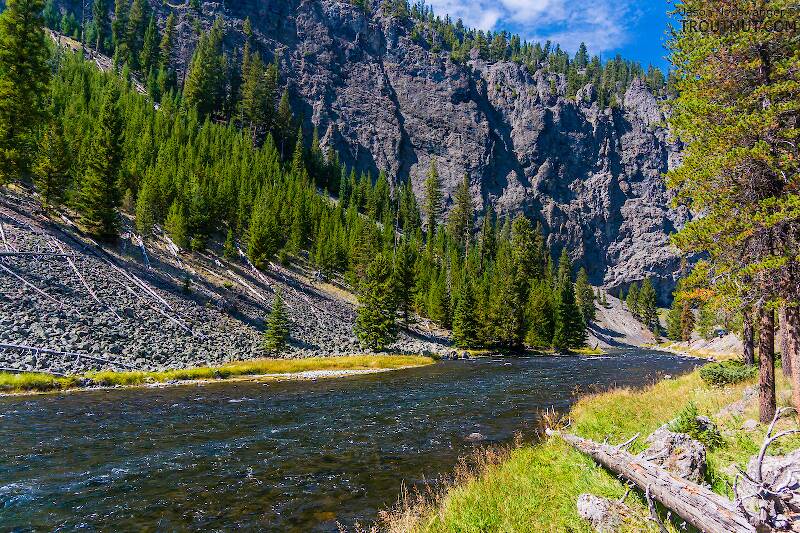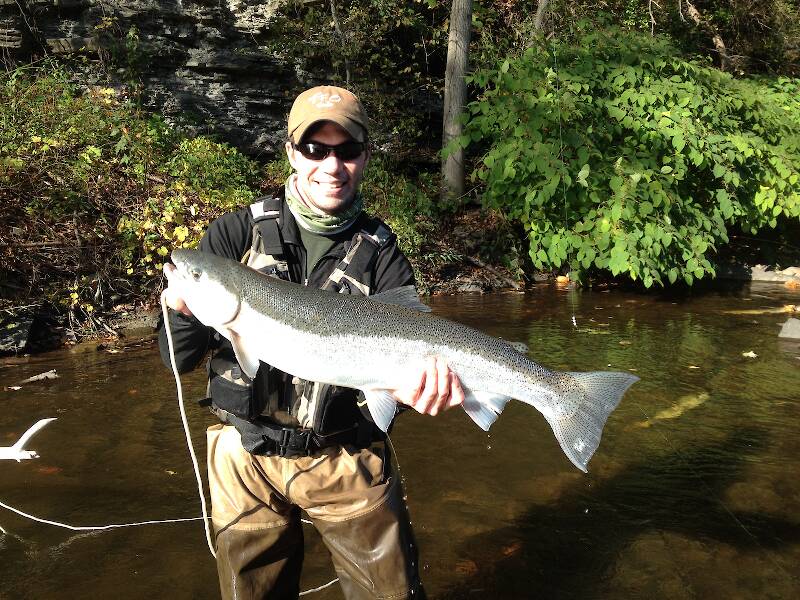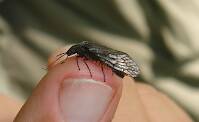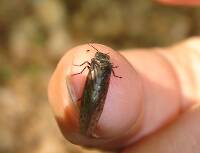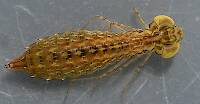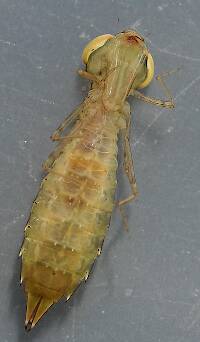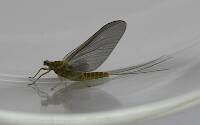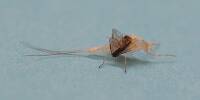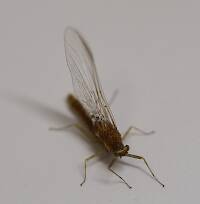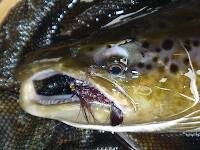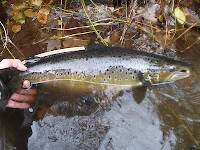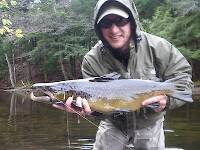
Salmonflies
Pteronarcys californica
The giant Salmonflies of the Western mountains are legendary for their proclivity to elicit consistent dry-fly action and ferocious strikes.
Featured on the forum

I caught this tiny larva without a case, but it seems to key pretty clearly to to Glossosomatidae. From there, the lack of sclerites on the mesonotum points to either Glossosoma or Anagapetus. Although it's difficult to see in a 2D image from the microscope, it's pretty clear in the live 3D view that the pronotum is only excised about 1/3 of its length to accommodate the forecoxa, not 2/3, which points to Glossosoma at Couplet 5 of the Key to Genera of Glossosomatidae Larvae.

Troutnut is a project started in 2003 by salmonid ecologist Jason "Troutnut" Neuswanger to help anglers and
fly tyers unabashedly embrace the entomological side of the sport. Learn more about Troutnut or
support the project for an enhanced experience here.
ADKbrookie has attached these 2 pictures to aid in identification. The message is below.
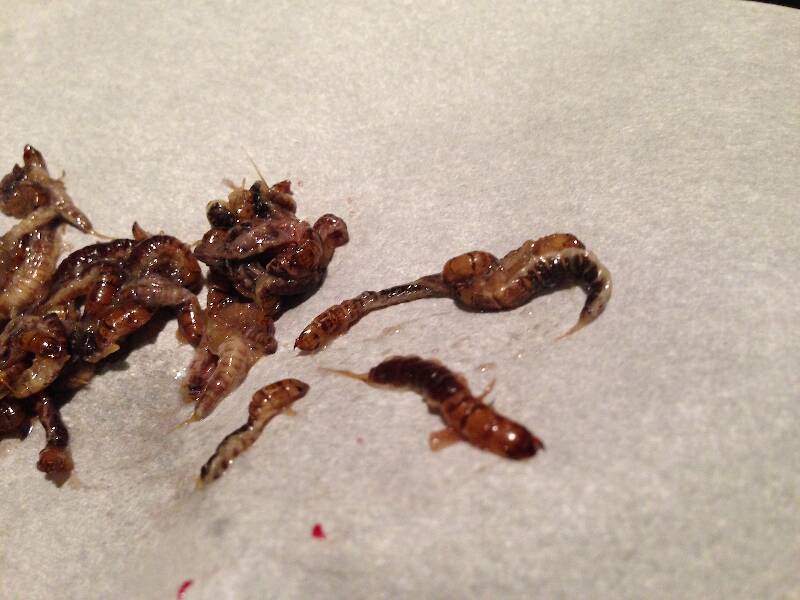

ADKbrookie on Apr 22, 2018April 22nd, 2018, 3:28 am EDT
The local lake has a healthy population of both lake trout and landlocked salmon. During the spring smelt run I target both by casting streamers from shore or trolling from a canoe. While lake trout often have smelt in their bellies all the salmon I’ve caught are filled with some caddisfly looking critter. It’s early, mid April in upstate NY and the water temp is between 42-50 degrees. I apologize here there is no scale to the image but I would estimate that each is between 1.5 - 3 cm in length.
Jmd123 on Apr 22, 2018April 22nd, 2018, 4:55 am EDT
Howdy, ADK. I don't think they are caddisflies, as I am seeing some tails on several individuals, also some big heads and jaws. Some might be neuropterans? Perhaps alderfly larvae? I could be wrong, not easy to see details, but the individual closest to the camera has a big head and mandibles.
I'll let the bug nuts on here try to get you a little closer to ID.
Jonathon
I'll let the bug nuts on here try to get you a little closer to ID.
Jonathon
No matter how big the one you just caught is, there's always a bigger one out there somewhere...
Millcreek on Apr 22, 2018April 22nd, 2018, 7:19 am EDT
Kevin - I'm pretty sure they're a Sialis species. Here are a couple of links.
http://www.troutnut.com/topic/9246/Sialis-sp
https://www.uoguelph.ca/debu/STEVEweb/html/Sialis_larva_NA_lg.htm
They're also known as alderflys, so Jonathan got it right.
http://www.troutnut.com/topic/9246/Sialis-sp
https://www.uoguelph.ca/debu/STEVEweb/html/Sialis_larva_NA_lg.htm
They're also known as alderflys, so Jonathan got it right.
"If we knew what it was we were doing, it would not be called research, would it?"
-Albert Einstein
-Albert Einstein
ADKbrookie on Apr 23, 2018April 23rd, 2018, 12:58 am EDT
Thank you, gentlemen! I would agree, they do look like alderfly larvae. I'm just perplexed how the salmon are feeding on them. I would think they would be picking them off as the larva swims to the surface to emerge but I've never seen much of any insect activity on the lake this early in the year. Do the larvae regularly swim throughout the water column?
Jmd123 on Apr 23, 2018April 23rd, 2018, 2:38 am EDT
Glad to be of help. I'm not highly familiar with the life cycle of the alderflies, though I do know that they lay their eggs on overhanging structures like bridges, the larvae dropping into the water upon hatching. I've seen the egg masses and they're pretty cool looking, like a little black patch of tiny ovoids clinging to the cement.
BTW, pretty fish! I would say tie a big-headed nymph of some sort and perhaps slowly lift it through the water column and see what happens! Good luck and send us more pics of your fishies.
Jonathon
BTW, pretty fish! I would say tie a big-headed nymph of some sort and perhaps slowly lift it through the water column and see what happens! Good luck and send us more pics of your fishies.
Jonathon
No matter how big the one you just caught is, there's always a bigger one out there somewhere...
Millcreek on Apr 23, 2018April 23rd, 2018, 4:39 am EDT
You're unlikely to find Sialis larvae in the water column as it is primarily a bottom feeder. They wouldn't be picking them off as emergers since the larvae crawl onto land and make a chamber under a log or in the soil and pupate there. You can find some info here: http://tolweb.org/Megaloptera
And a photo of an alderfly pupae here:http://joycegross.com/images.php?img=2222_1745
And a photo of an alderfly pupae here:http://joycegross.com/images.php?img=2222_1745
"If we knew what it was we were doing, it would not be called research, would it?"
-Albert Einstein
-Albert Einstein
Quick Reply
Related Discussions
Topic
Replies
Last Reply
4
Apr 12, 2014
by Brookyman
by Brookyman

